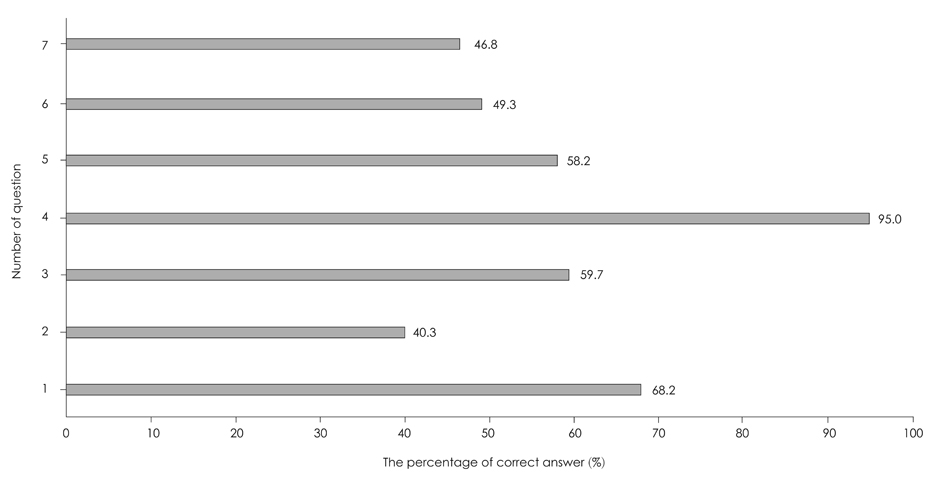Korean J Nutr.
2011 Feb;44(1):74-81. 10.4163/kjn.2011.44.1.74.
An Evaluation of Food Delivery Worker Sanitation Management Practices that Supply Food to School Foodservices
- Affiliations
-
- 1Department of Food Science and Nutrition, Kyungpook National University, Daegu 702-701, Korea. yklee@knu.ac.kr
- KMID: 2268352
- DOI: http://doi.org/10.4163/kjn.2011.44.1.74
Abstract
- The purpose of this study was to investigate the sanitation management of school foodstuffs and the sanitation knowledge of delivery company workers. A questionnaire that identified employee's food safety sanitation management, knowledge, and practices was developed based on a review of the literature. The subjects consisted of 201 delivery company workers from 38 delivery companies in the Daegu and Gyeongbuk area. The workers were 30-39 years of age (41.3%) with 1-3 years of working experience (30.8%). Approximately 62% of the respondents were educated and had 1-2 years of food safety experience, 52.7% of the respondents delivered foodstuffs to two schools in the morning. The total score for delivery company worker sanitation knowledge was 3.75/7.00, which was low. The total mean sanitary performance score for factory workers was 4.58/5.00. They indicated that the most difficult part of the operation is delivering on time. Temperature management was another difficulty. In order to secure the best quality of school food to be supplied safely, the thorough sanitation education must be conducted to the school dieticians and delivery company managers.
Keyword
Figure
Reference
-
1. Annual Listing of Foodborne Disease Outbreaks, United States. CDC (Centers for Disease Control and Prevention). 2010. available from: http://www.cdc.gov/foodborneoutbreaks/outbreak_data.htm.2. Foodborne outbreak statistics. Ministry of Health, Labour and Welfare. 2010. available from: http://www.mhlw.go.jp/topics/syokuchu/04.htmL.3. Foodborne disease outbreaks. KFDA (Korea food drug administration). 2010. available from: http://fm.kfda.go.kr/.4. Kwak TK, Moon HK. School food safety practices in USA. J Korean Diet Assoc. 2005. 11(4):473–484.5. Sivapalasingam S, Friedman CR, Cohen L, Tauxe RV. Fresh produce: A growing cause of outbreaks of foodborne illness in the United States, 1973 through 1997. J Food Prot. 2004. 67(10):2342–2353.
Article6. Gallay A. Toxines microbiennes dans les toxi-infections alimentaires collectives déclarées en France. 2002. In : Congress of the French Society of Microbiology November Paris;7. Medeiros LC, Hillers VN, Kendall P, Mason A. Food safety ed-ucation what should we be teaching to consumers? J Nutr Educ. 2001. 33(2):108–113.
Article8. Kim KA, Kwak TK, Lee KE. Food purchasing and quality ma-nagement practices in school food service. J Korean Diet Assoc. 2006. 12(4):329–341.9. Park KH. Research report: 07032기타사801. Development of generic HACCP model for food distribution channel. 2007. Korean Food & Drug Administration.10. Park JY, Ahn SS, Park HH. A study on differences of food hygiene knowledge and practices between housewives and the contract foodservices employes. Korean J Food Nutr. 2006. 19(3):301–310.11. Ministry for Food, Agriculture, Forestry and Fisheries & Ministry of Health and Welfare. Enforcement Decree of the Food Sanitation Act. 2007.12. Kim YH. A survey of sanitation management on the manufacturing and distribution steps associated with, and assessment of microbiological safety of, school foodservice food [Doctor's Thesis]. 2009. Daegu: Kyungpook National University.13. Kim YH, Ryu K, Lee YK. Microbiological safety during delivering of food ingredients supplied to elementary school food services in Daegu and Gyeongbuk provinces-seafood, meat and frozen processing food-. Korean J Food Preserv. 2009. 16(2):276–285.14. Hong WS, Yim JM. Evaluation of foodservice employees' sanitary performance and sanitary education in middle and high schools in Seoul. J Korean Diet Assoc. 2009. 15(2):113–127.15. Kim SO, Oh MS. Sanitary management performance and knowledge of employees in hospital food service. J Korean Home Econ Assoc. 2005. 43(11):127–140.16. Han EH. Evaluation of knowledge and practice level of hygiene for school cafeteria employees in Jeonju [MS thesis]. 2003. Jeonju: Chonbuk National University.17. Nunnally JC. Psychometric theory. 1978. 2nd ed. New York: Megraw-hill.18. Ministry of education, science and technology. School food hygiene and management guidelines. 2010.19. Seoul Metropolitan Office of Education. The basic direction of school foodservice. 2009.20. Lee YE. A Study on the perception and practice of sanitation training program at school foodservice operations in Chungbuk province. J Korean Diet Assoc. 2006. 12(1):68–81.21. Kim YH, Ryu K, Lee YK. Microbiological safety during delivering of food ingredients supplied to elementary school food services in Daegu and Gyeongbuk provinces-seafood, meat and frozen processing food-. Korean J Food Preserv. 2009. 16(2):276–285.22. Eo GH, Ryu K, Park SJ, Kwak TK. Need assessment of HACCP-based sanitation training program in elementary school food-service operations based on sanitation knowledge test of employees. J Korean Diet Assoc. 2001. 7(1):56–64.23. Li-Cohen AE, Bruhn CM. Safety of consumer handling of fresh produce from the time of purchase to the plate: A comprehensive consumer survey. J Food Prot. 2002. 65(8):1287–1296.
Article24. Chong YK, Kwak TK. Perceived performance of sanitary management for school food service managers in the Seoul area. Korean J Community Nutr. 2000. 5(1):100–108.
- Full Text Links
- Actions
-
Cited
- CITED
-
- Close
- Share
- Similar articles
-
- Evaluation of Hygienic Status using ATP Bioluminescence Assay and Food Service Workers' Sanitation Performance in Elderly Welfare Facilities
- Customer Satisfaction Index of Business & Industry Foodservice Operations in Pusan and Kyeung Nam Area
- Comparison of the Sodium and Sugar Reduction Practices at Samsam Foodservices and General Foodservices in Daegu
- A Comparative Study on Sanitary practices and Perception of Employees in Elementary School, Hospital and Industry Food Service in the Inchon Area
- Requirements and Self-evaluation of Knowledge and Skills Necessary for Effective Nutrition Teachers Perceived by School Foodservice Deititians


